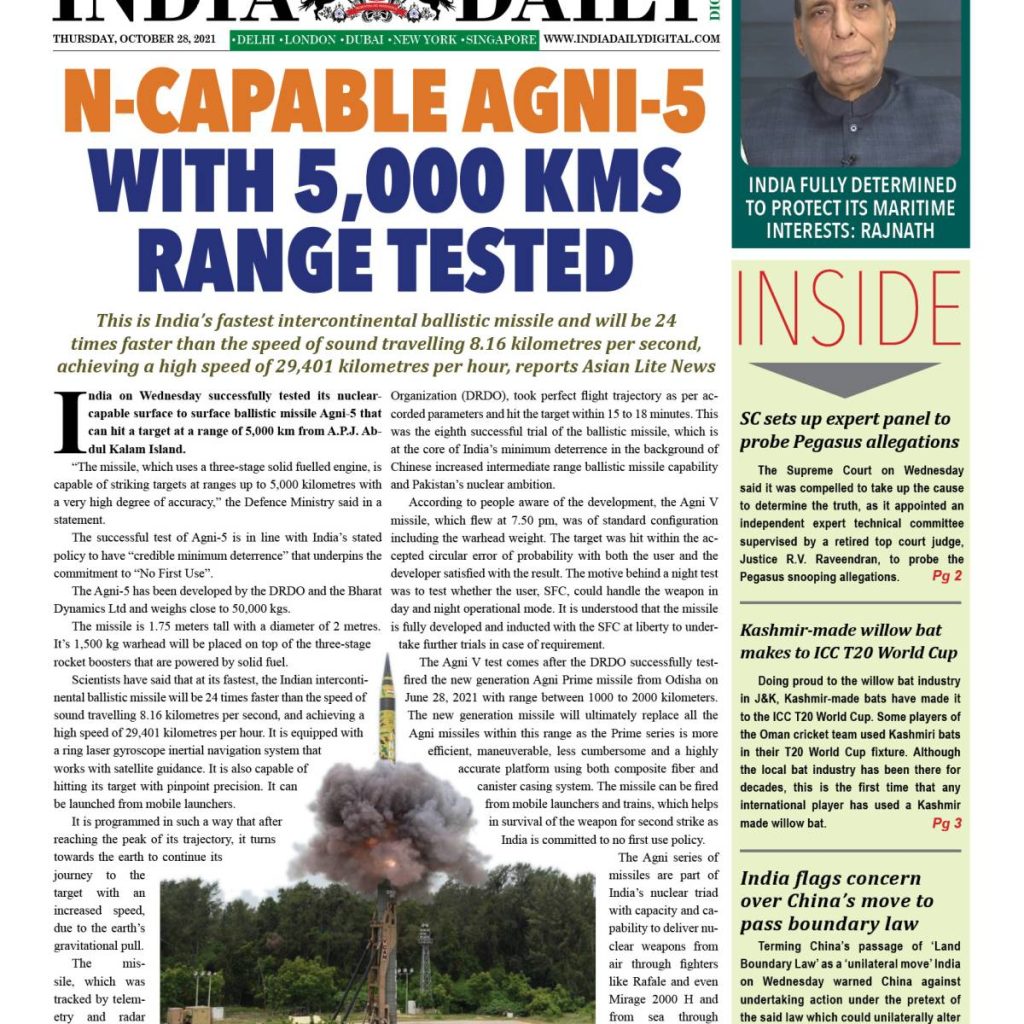This is India’s fastest intercontinental ballistic missile and will be 24 times faster than the speed of sound travelling 8.16 kilometres per second, achieving a high speed of 29,401 kilometres per hour, reports Asian Lite News
India on Wednesday successfully tested its nuclear-capable surface to surface ballistic missile Agni-5 that can hit a target at a range of 5,000 km from A.P.J. Abdul Kalam Island.
“The missile, which uses a three-stage solid fuelled engine, is capable of striking targets at ranges up to 5,000 kilometres with a very high degree of accuracy,” the Defence Ministry said in a statement.
The successful test of Agni-5 is in line with India’s stated policy to have “credible minimum deterrence” that underpins the commitment to “No First Use”.
The Agni-5 has been developed by the DRDO and the Bharat Dynamics Ltd and weighs close to 50,000 kgs.
The missile is 1.75 meters tall with a diameter of 2 metres. It’s 1,500 kg warhead will be placed on top of the three-stage rocket boosters that are powered by solid fuel.
Scientists have said that at its fastest, the Indian intercontinental ballistic missile will be 24 times faster than the speed of sound travelling 8.16 kilometres per second, and achieving a high speed of 29,401 kilometres per hour.
It is equipped with a ring laser gyroscope inertial navigation system that works with satellite guidance.
It is also capable of hitting its target with pinpoint precision. It can be launched from mobile launchers.

It is programmed in such a way that after reaching the peak of its trajectory, it turns towards the earth to continue its journey to the target with an increased speed, due to the earth’s gravitational pull.
The missile, which was tracked by telemetry and radar ships of the Defence Research and Development Organization (DRDO), took perfect flight trajectory as per accorded parameters and hit the target within 15 to 18 minutes. This was the eighth successful trial of the ballistic missile, which is at the core of India’s minimum deterrence in the background of Chinese increased intermediate range ballistic missile capability and Pakistan’s nuclear ambition.
According to people aware of the development, the Agni V missile, which flew at 7.50 pm, was of standard configuration including the warhead weight. The target was hit within the accepted circular error of probability with both the user and the developer satisfied with the result. The motive behind a night test was to test whether the user, SFC, could handle the weapon in day and night operational mode. It is understood that the missile is fully developed and inducted with the SFC at liberty to undertake further trials in case of requirement.
The Agni V test comes after the DRDO successfully test-fired the new generation Agni Prime missile from Odisha on June 28, 2021 with range between 1000 to 2000 kilometers. The new generation missile will ultimately replace all the Agni missiles within this range as the Prime series is more efficient, maneuverable, less cumbersome and a highly accurate platform using both composite fiber and canister casing system. The missile can be fired from mobile launchers and trains, which helps in survival of the weapon for second strike as India is committed to no first use policy.
The Agni series of missiles are part of India’s nuclear triad with capacity and capability to deliver nuclear weapons from air through fighters like Rafale and even Mirage 2000 H and from sea through ballistic missile submarines like INS Arihant.
ALSO READ-India readies to test indigenous ICBM
READ MORE-Indigenous aircraft carrier Vikrant sails out for second sea trials

